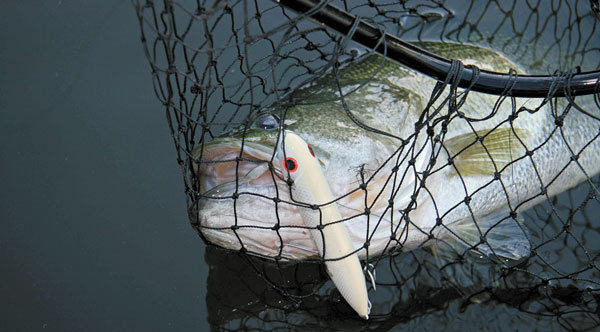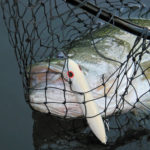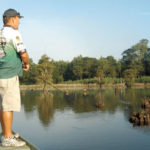
When I think about bass fishing in September, one word immediately comes to mind: topwater.
I love to catch fish on topwater baits, and September is a tremendous month for topwater action if you’re a fisherman in South Carolina. Even though it’s basically a summer month, you start to have some cooler nights, the water temperature drops ever so slightly, and fish get a little more aggressive.
What makes for a good topwater bite is that most of the bass in our lakes have been suspended for two months. With the water temperatures so high in July and August, you’ve had fish suspended, maybe hanging around the thermocline. Then, you get the combination of the water starting to cool a little, the fish being suspended, and the fish getting a little more aggressive, and you have perfect conditions for a topwater bite.
You can get some good topwater action in October, but not every year. It’s not as consistent as September, which is a great topwater month.
The first thing to think about is where to fish. Because fish are still in their summertime places — this topwater bite gets started before they start to move back in the creeks — I’m going to fish main-lake areas. I’m still going to be fishing a summertime pattern, but I’m going to keep one rod rigged in case a single fish or a school of fish suddenly shows up busting bait at the surface.
I’m going to want a walking bait, something like a Rapala Skitter Walk. You can make long casts with a big bait like that, and you’ve got to be able to if you see fish breaking. I’ll always have at least one tied on, and I’ll fish it on a 7-foot, medium-action All-Star rod. I’ll throw it on 30-pound Spiderwire Ultra Cast, because Ultra Cast is made for longer casts, and it helps solve another problem that crops up from time to time. When you need to make a 40-yard cast and the fish bites, at that range, it’s hard to get a good hookset. That’s why you see a lot of fish throwing the bait when they jump. Ultra Cast has zero stretch, so that helps. When a bass hits your bait, you feel him, then you just pull back and you get a hookset that’s much better than what you’d get with monofilament.
There’s a second kind of topwater bite I’m looking for that’s completely different, and I’ll use completely different baits. This time, I’m looking to trigger a strike at the surface, and I’m not necessarily casting in open water; lots of times I’m target fishing around or above cover.
I like to fish a popping bait like a Skitter Pop and a prop bait like a Skitter Prop. You want to pull the more aggressive fish to the surface to strike. The noise a popping bait or a prop bait makes is very similar to fish schooling on the surface. A Skitter Pop makes sort of a “pop, pop, pop” noise, while a Skitter Prop makes more of a “bloop, bloop, bloop” noise. I feel like most bass think that another bass is chasing a baitfish, and they want to get in on the feeding action. Fish can hear the noise or feel the vibration five to 10 to 15 feet away. It calls up suspended bass.
I will usually have one of each bait tied on, because you never know exactly which one will work better from day to day. One day, it seems like bass want the popping bait, and the next day, they want the prop bait. I’ve been fishing professionally for 18 years, and I don’t know what makes them choose between the “popping” of a Skitter Pop and the “blooping” or “gurgling” of a the Skitter Prop. From one day to the next, they’ll get in a different mood and want something different.
I fish the walking bait over open water, but bass can be at any depth. Depending on the weather, you can have 100-degree temperatures in September and you get fish that are 20 feet deep, or you can have four or five days of rainy, cloudy weather and they can be in one foot of water.
I fish the popping and prop baits around cover, both visible and underwater cover. It may be a brushpile you can see, or maybe some rocks or stumps you don’t. Those baits just seem to work better when you’re working them over or past cover where fish may be holding.
One thing that’s good about fishing the popping and prop baits is that you can cover a lot of water while you’re trying to figure out which one the bass want. Then, just like you were fishing a crankbait, you start to find a key depth where bass are holding, and you develop a pattern.
The other thing you pay attention to is bait. One creek may hold all the bass one year, then the next year, they all go back up a different one. I look for bait, either bait that’s popping at the surface or bait I can see on my Humminbird depthfinder. You’ll see more bait around the mouth of the creeks that are going to get the most attention from bass. You’ll see more clutter on your depthfinder. Keep in mind that where you find bait, that’s where you’ll find the best concentrations of bass.
And when I get that figured out, I slow down and spend more time around the mouth of those creeks — with my topwater baits.






Be the first to comment